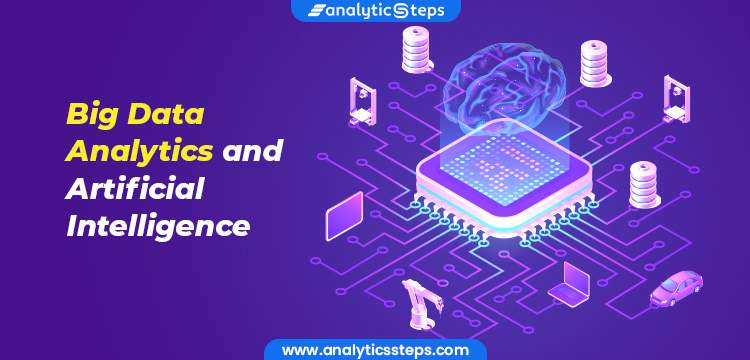Artificial Intelligence (AI) and Data Analytics are two of the most rapidly growing technologies that are transforming the way businesses operate and make decisions. These technologies enable organizations to analyze vast amounts of data, identify patterns and trends, and gain valuable insights to make informed decisions.
Toc
Introduction of Artificial Intelligence and Data Analytics

Artificial intelligence (AI) is no longer a futuristic concept. It has rapidly become an integral part of modern technology, especially in data analytics. AI’s role in revolutionizing data analytics is profound, offering unprecedented insights and efficiencies for businesses and tech enthusiasts alike. This article explores the growing importance and applications of AI within the realm of data analytics.
What is AI in Data Analytics?
AI in data analytics refers to the use of advanced algorithms and intelligent systems to analyze large datasets, identify patterns, and make predictions without explicit instructions. It combines computer science, mathematics, and statistics to process vast amounts of structured and unstructured data within a short time accurately. The primary goal of AI in data analytics is to automate the analysis process and provide actionable insights that drive informed decision-making.
Importance of AI in Data Analytics
The ever-growing volume, variety, and velocity of data make it challenging for humans to derive valuable insights manually. That’s where AI comes into play. Here are some key reasons why AI is crucial in data analytics:
- Efficiency and Speed: AI-powered systems can process vast amounts of data, analyze it in real-time, and provide insights quickly. This saves time and effort compared to manual analysis.
- Accuracy and Precision: AI eliminates human errors and biases, ensuring accurate and precise analysis results.
- Predictive Capabilities: By analyzing historical data, AI algorithms can predict future outcomes with a high level of accuracy. This allows businesses to anticipate market trends, customer behavior, and make well-informed decisions.
- Cost Savings: The automation of the data analysis process through AI reduces the need for human resources, resulting in cost savings for businesses.
Applications of AI in Data Analytics
The potential applications of AI in data analytics are vast and diverse, with new use cases emerging every day. Some notable applications include:
- Customer Segmentation: By analyzing customer data, AI can segment customers based on demographics, preferences, and behavior patterns. This helps businesses personalize their marketing strategies and improve customer experience.
- Fraud Detection: AI algorithms can analyze large volumes of financial transactions to identify fraudulent ones accurately. This plays a crucial role in fraud detection and prevention for banks and other financial institutions.
- Healthcare Diagnostics: AI-powered systems can analyze medical data, including patient records and test results, to assist doctors in making accurate diagnoses and treatment plans.
- Supply Chain Optimization: By analyzing data on inventory levels, consumer demand, and distribution patterns, AI can optimize the supply chain process for businesses.
AI is shaping tomorrow’s decisions

Enhancing Decision-Making with AI
With the ability to process and analyze massive datasets rapidly and accurately, AI significantly enhances decision-making processes across various industries. Businesses are leveraging AI to gain a competitive edge by making data-driven decisions that are not only timely but also highly reliable. Here are some key ways AI is shaping tomorrow’s decisions:
- Personalized Customer Experiences: AI helps businesses create highly personalized customer journeys by analyzing interactions and preferences. This leads to improved customer satisfaction and retention rates.
- Financial Forecasting: AI models provide financial institutions with precise forecasting abilities. These models can predict market trends, assess risks, and guide investment decisions, thereby maximizing returns and minimizing losses.
- Operational Efficiency: AI optimizes operations by identifying inefficiencies and recommending process improvements. This increases productivity and reduces operational costs.
- Strategic Planning: AI-driven insights enable companies to develop well-informed strategic plans. By forecasting future trends and market demands, businesses can allocate resources more effectively and position themselves advantageously.
- Human Resources Management: AI applications in HR include talent acquisition, employee performance analysis, and predictive analytics for workforce planning. These tools help in making more informed and unbiased HR decisions.
Challenges and Considerations
While AI offers numerous benefits, it also presents challenges and considerations that organizations must address:
- Data Privacy and Security: Handling large volumes of sensitive data requires stringent data privacy and security measures to prevent breaches and misuse.
- Ethical Considerations: The use of AI in decision-making processes must be transparent and ethical. Ensuring that AI algorithms do not perpetuate biases or unfair practices is crucial.
- Integration with Existing Systems: Incorporating AI into existing business infrastructures can be complex and require significant investments in technology and training.
- Regulatory Compliance: Organizations must ensure that their use of AI complies with relevant regulations and standards to avoid legal repercussions.
Despite these challenges, the benefits of AI in data analytics far outweigh the potential drawbacks when implemented thoughtfully and responsibly. AI is not just transforming how decisions are made today, but it is also paving the way for more intelligent and futuristic decision-making processes in tomorrow’s business landscape.
AI in Predictive Analysis

Leveraging AI for Predictive Analysis
Predictive analysis leveraging AI helps organizations foresee future trends, behaviors, and events by analyzing historical data. This proactive approach is transforming various industries by enabling more strategic planning and risk management. Here are some key applications of AI in predictive analysis:
- Sales Forecasting: AI models can analyze historical sales data, seasonal trends, and market conditions to predict future sales performance. This helps businesses in planning inventory, marketing strategies, and budgeting efficiently.
- Risk Management: Financial institutions use AI for predictive risk analysis to assess credit risks, market fluctuations, and potential defaults. This helps in making informed lending decisions and improving portfolio management.
- Customer Churn Prediction: By analyzing customer interactions, purchase history, and feedback, AI can predict which customers are likely to churn. Companies can then take proactive measures to retain these customers by offering targeted promotions or improving customer service.
- Maintenance and Equipment Failure: AI-powered predictive maintenance tools analyze data from machinery and equipment to predict when maintenance should be performed, thereby preventing unexpected breakdowns and extending the lifespan of assets.
- Healthcare Prognostics: In healthcare, predictive analysis uses patient data to predict the likelihood of diseases or medical conditions, enabling early intervention and personalized treatment plans.
Future Trends in AI and Data Analytics
The field of AI in data analytics is continually evolving, with several emerging trends shaping the future landscape:
- Explainable AI: As AI systems become more integral in decision-making, there’s a growing need for these systems to be transparent and interpretable. Explainable AI aims to make AI decision processes understandable to humans, thus increasing trust and adoption.
- Edge AI: With the proliferation of IoT devices, edge AI processes data on local devices rather than centralized servers, reducing latency and improving real-time decision-making capabilities.
- AI Democratization: Making AI tools and technologies more accessible to non-experts is a significant trend. Platforms offering user-friendly interfaces and automation of complex tasks aim to democratize AI, enabling a broader range of users to leverage its power.
- Sustainable AI: There is an increasing emphasis on creating eco-friendly AI models that consume less energy and contribute to sustainability goals. This includes optimizing algorithms and using renewable energy sources for data centers.
Challenges and Ethical Considerations

As AI and data analytics continue to evolve, it is essential for organizations to stay ahead of the curve by addressing the challenges and ethical considerations that come with these advancements. Here are some additional points to consider:
Addressing Bias in AI
One major challenge in AI is ensuring that algorithms are free from bias. Bias can be introduced during the data collection phase, through the choice of training data, or even from the way algorithms are designed. This can lead to discriminatory practices, reduced fairness, and ethical concerns. Organizations should focus on creating diverse datasets and regularly auditing their AI models to identify and mitigate biases.
Skills and Training
The rapid advancements in AI technologies require a skilled workforce that can develop, maintain, and improve these systems. Therefore, investing in continuous education and training programs for employees is crucial. Organizations can partner with academic institutions, offer certifications, and encourage participation in workshops and conferences to keep their teams updated on the latest trends and techniques in AI and data analytics.
Robust Data Governance
Effective data governance is critical for the successful implementation of AI. Organizations must establish clear policies and procedures for data management, including data quality, privacy, security, and ethical use. This ensures that the data driving AI models is reliable and compliant with legal and regulatory standards.
Cross-Disciplinary Collaboration
AI and data analytics projects often require input and expertise from multiple disciplines, including computer science, statistics, domain-specific knowledge, and ethics. Encouraging collaboration across departments and creating interdisciplinary teams can lead to more innovative and effective AI solutions.
Continuous Monitoring and Improvement
The dynamic nature of AI models requires continuous monitoring and updating to maintain their accuracy and relevance. Regularly evaluating model performance, incorporating new data, and adjusting algorithms as needed helps ensure that AI applications remain effective and reliable over time.
By addressing these considerations, organizations can harness the power of AI and data analytics to drive innovation, improve decision-making, and maintain a competitive edge in the rapidly changing business landscape. Also, adopting a responsible and ethical approach to AI will help build trust and ensure that these technologies are used for the greater good.
Best Practices for AI Integration in Data Analytics

Successfully incorporating AI into existing data analytics strategies requires careful planning and execution.
Clear Objectives and Goals
Before integrating AI into data analytics, it is important for organizations to clearly define their objectives and goals. Understanding what the organization aims to achieve—whether it’s improving operational efficiency, enhancing customer experience, or driving innovation—will guide the implementation process and ensure alignment with the overall business strategy.
Quality Data Collection
The foundation of any AI initiative is high-quality data. Organizations should focus on collecting comprehensive, accurate, and relevant data from various sources. Ensuring data cleanliness and consistency through preprocessing techniques such as deduplication, normalization, and validation is crucial for building reliable AI models.
Scalable Infrastructure
An effective AI integration requires scalable infrastructure to support the storage, processing, and analysis of large volumes of data. Investing in cloud-based services, distributed computing platforms, and robust data pipelines can help organizations manage and scale their AI operations efficiently.
Pilot Projects
Starting with pilot projects can provide valuable insights into the feasibility and impact of AI applications. By selecting small, manageable projects with clear metrics for success, organizations can experiment with AI technologies, identify potential challenges, and refine their approaches before scaling up.
Stakeholder Engagement
Engaging stakeholders from across the organization early and often is critical for successful AI integration. This includes securing buy-in from leadership, involving end-users in the development process, and maintaining open lines of communication to address concerns and expectations. A collaborative approach helps ensure that AI solutions meet the needs of all stakeholders.
Ethical Considerations
Organizations must prioritize ethical considerations when deploying AI in data analytics. This involves being transparent about how AI is used, ensuring data privacy and security, and addressing potential biases in AI models. By fostering an ethical culture, organizations can build trust with customers, employees, and other stakeholders.
Continuous Learning and Adaptation
The AI landscape is constantly evolving, requiring organizations to stay updated on the latest advancements and best practices. Encouraging a culture of continuous learning and adaptation—through training programs, knowledge sharing, and active monitoring of industry trends—will help organizations remain competitive and innovative in their AI endeavors.
By following these best practices, organizations can effectively integrate AI into their data analytics strategies, unlocking new opportunities for growth and efficiency.
Conclusion

AI’s role in data analytics is undeniably transformative. From improving decision-making processes to offering predictive insights, AI is a crucial tool for modern businesses. However, addressing challenges such as data privacy and bias is essential for ethical AI deployment. By adopting best practices and staying informed about future advancements, organizations can harness the full potential of AI in data analytics.
Ready to revolutionize your data analytics strategy with AI? Sign up for our free trial of Jasper today and experience the future of data-driven decision-making.












